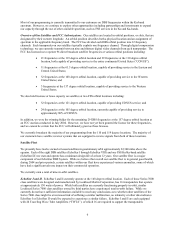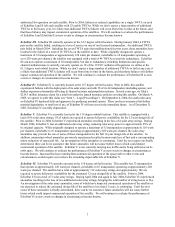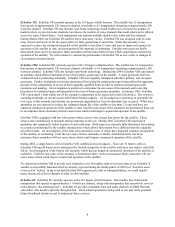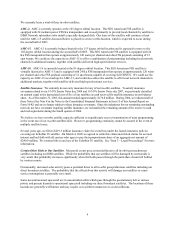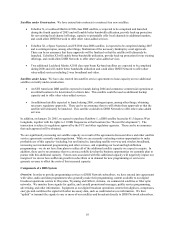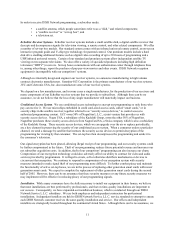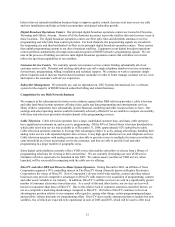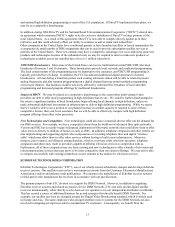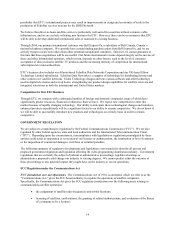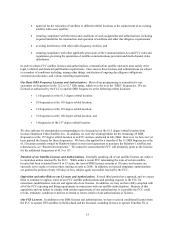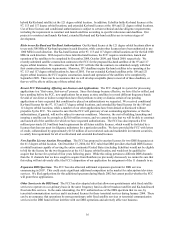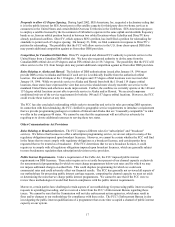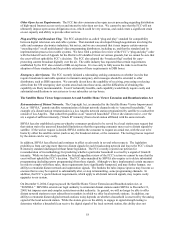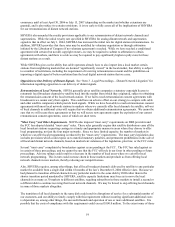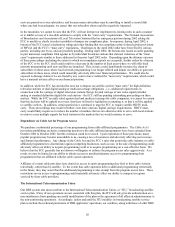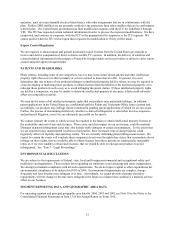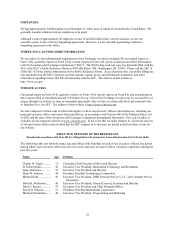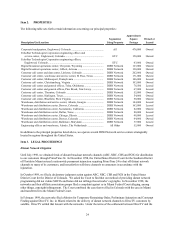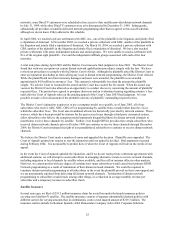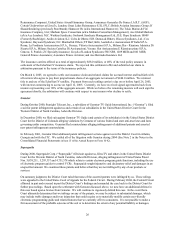Dish Network 2004 Annual Report Download - page 24
Download and view the complete annual report
Please find page 24 of the 2004 Dish Network annual report below. You can navigate through the pages in the report by either clicking on the pages listed below, or by using the keyword search tool below to find specific information within the annual report.16
hybrid Ka/Ku-band satellite) at the 121 degree orbital location. In addition, EchoStar holds Ka-band licenses at the
97, 113 and 117 degree orbital locations, and extended Ku-band licenses at the 109 and 121 degree orbital locations.
Use of these licenses and conditional authorizations is subject to certain technical and due diligence requirements,
including the requirement to construct and launch satellites according to specific milestones and deadlines. Our
projects to construct and launch Ku-band, extended Ku-band and Ka-band satellites are in various stages of
development.
Risks to our Ka-Band and Ku-Band Authorizations Our Ka-band license at the 121 degree orbital locations allow us
to use only 500 MHz of Ka-band spectrum in each direction, while certain other licensees have been authorized to use
1000 MHz in each direction. Our Ka-band licenses at the 97, 113 and 117 degree orbital locations are for the full 1000
MHz in each direction. With respect to these latter Ka-band licenses, the FCC requires construction, launch and
operation of the satellites to be completed by December 2008, October 2009, and March 2009, respectively. We
recently submitted satellite construction contracts to the FCC for the proposed Ka-band satellites at the 97 and 117
degree orbital locations. We cannot be sure that the FCC will rule that the contracts we submitted comply with their
first construction milestone requirements. Moreover, ITU deadlines require Ka-band satellites to be operating at the
97, 113 and 117 degree orbital locations by June of 2005. For our extended Ku-band satellites at the 109 and 121
degree orbital locations, the FCC requires construction, launch and operation of the satellites to be completed by
September 2009. There can be no assurance that we will develop acceptable plans to meet all of these deadlines, or
that we will be able to utilize any of these orbital slots.
Recent FCC Rulemaking Affecting our Licenses and Applications. The FCC changed its system for processing
applications to a “first-come, first-served” process. Since that change became effective, we have filed or refiled, and
have pending before the FCC, new applications for as many as nine satellites in several different frequency bands.
Several of our direct or indirect competitors have filed petitions to deny or dismiss certain of our pending
applications or have requested that conditions be placed on authorizations we requested. We received conditional
Ka-band licenses for the 97, 113 and 117 degree orbital locations, and extended Ku-band licenses for the 109 and
121 degree orbital locations, while a number of our other applications have been denied or dismissed without
prejudice by the FCC. We cannot be sure that the FCC will grant any of our outstanding applications, or that the
authorizations, if granted, will not be subject to onerous conditions. Moreover, the cost of building, launching and
insuring a satellite can be as much as $250.0 million or more, and we cannot be sure that we will be able to construct
and launch all of the satellites for which we have requested authorizations. The FCC has also imposed a $3.0
million (previously $5.0 million) bond requirement for all future satellite licenses, which would be forfeited by a
licensee that does not meet its diligence milestones for a particular satellite. We have provided the FCC with letters
of credit, collateralized by approximately $15.8 million of our restricted cash and marketable investment securities,
to satisfy this requirement for all of our Ka-band and extended Ku-band licenses.
New Satellite License Auction Proceedings. The FCC has proposed to auction licenses for two DBS frequencies at
the 61.5 degree orbital location. On December 27, 2004, the FCC ruled that DBS providers that hold DBS licenses
at orbital locations capable of serving the entire continental United States (including EchoStar) would not be eligible
to bid for the license for the two frequencies at the 61.5 degree orbital location, and would not be qualified to
acquire that license for a period of four years following grant. While this ruling pertains to different DBS channels
than the 11 channels that we have sought to acquire from Rainbow (as previously discussed), we cannot be sure that
this ruling will not adversely affect the FCC's disposition of our application for assignment of the 11 channels to us.
Expansion DBS Spectrum. The FCC has also allocated additional expansion spectrum for DBS services
commencing in 2007. This could create significant additional competition in the market for subscription television
services. We filed applications for this additional spectrum during March 2002 but cannot predict whether the FCC
will grant these applications.
Other Services in the DBS band. The FCC has also adopted rules that allow non-geostationary orbit fixed satellite
services to operate on a co-primary basis in the same frequency band as direct broadcast satellite and Ku-band-based
fixed satellite services. In the same rulemaking, the FCC authorized use of the DBS spectrum that we use, by
terrestrial communication services and it auctioned licenses for these terrestrial services during January 2004. There
can be no assurance that operations by non-geostationary orbit fixed satellite services or terrestrial communication
services in the DBS band will not interfere with our DBS operations and adversely affect our business.


